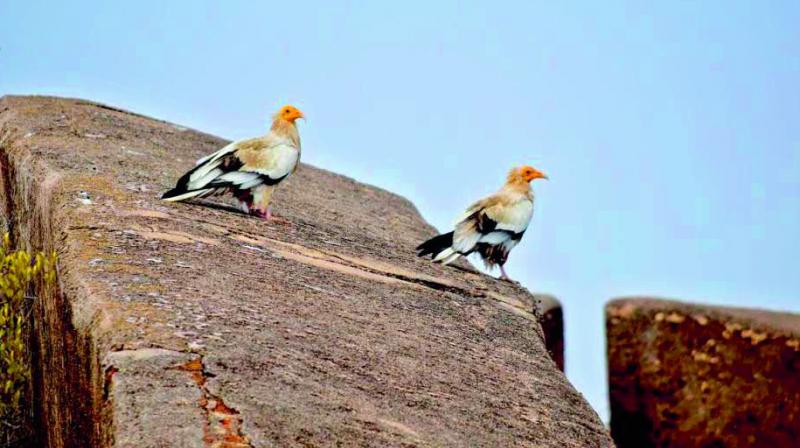Egyptian vultures at Ratnagiri Fort hill
The winged guests migrate to South in winter season.

Anantapur: After a long gap of 15 years, an endangered species of vulture was spotted on the hilltop of Ratnagiri Fort area by V. Jayachandra and Sridevi from the Radha School of Learning in Anantapur.
They had gone trekking with their teachers on Thursday. “While we were trekking towards the top of the hill, we noticed from a distance of about 50 metres, two birds, which, after being closely watched, were identified as Egyptian vultures”, Jayachandra and Sridevi told this newspaper. Mr Jayachandra, whose hobby is photography, caught the rare species of birds on his camera.
Ratnagiri Fort is located in Rolla mandal close to the Karnataka border. The International Union for Cons-ervation of Nature and Natural Resources (IUCN) had declared the white vultures an endangered species following the decline of this species in the 20th century due to hunting, accidental poisoning, and collision with power lines. The vulture is a useful scavenger and plays a key role in the environment as ecosystem service provider.
Ratnagiri Fort is close to the Karnataka state capital of Bengaluru, at a distance of 103.9 km and 426.6 kms away from Hyderabad. It was one of the forts of historic importance during the Pandya and Chola Dynasties. Later it fell into the hands of Hyder Ali. It is also believed that after the fall of the Vijayanagaram Kingdom, Allasani Peddana and around 500 Brahmin families settled at Ratnagiri, which has a latitude of 13.809224 and a longitude of 77.1298204.
The appearance of the Egyptian vultures in drought-hit parts of Rayalaseema region after a long gap, is a good sign, said the two students. They observed: “The steep, high hill appears to suit the endangered birds and their population could increase if the government protected the species”.
Historically, the vulture was used as a symbol for Rayalaseema during the Rayalaseema agitation by the Rayalasema Vimochana Samiti two decades ago. The birds feed on carrion and keep the natural environment clean and control viral disease from infecting decaying carrion. Egyptian vultures feed mainly on carrion, but are opportunistic and will prey on small mammals, birds, and reptiles.
They also feed on the eggs of other birds, breaking larger ones by tossing a large pebble on to them. The use of tools is rare in birds and apart from the use of a pebble as a hammer, Egyptian vultures also use twigs to roll up wool for use in their nests and breed in the temperate regions. They migrate south in winter. Tropical populations are relatively sedentary.
The vulture (Neophron percnopterus), was a frequently-seen bird in the Indian sub-continent, but rapidly declined in the country largely due to the toxic effect of veterinary drugs.
When this correspondent brought the Egyptian vultures to the notice of the forest official, Anantapur DFO A. Chandrasekhar said the forest department would immediately initiate measures to protect the endangered species at Ratnagiri hill. Steps would also be taken to create awareness among the public, he said.
"Due to extremely rapid population decline in India this species has been enlisted as Endangered (EN) vulture species in the IUCN Red-list of Threatened Species in 2012".

